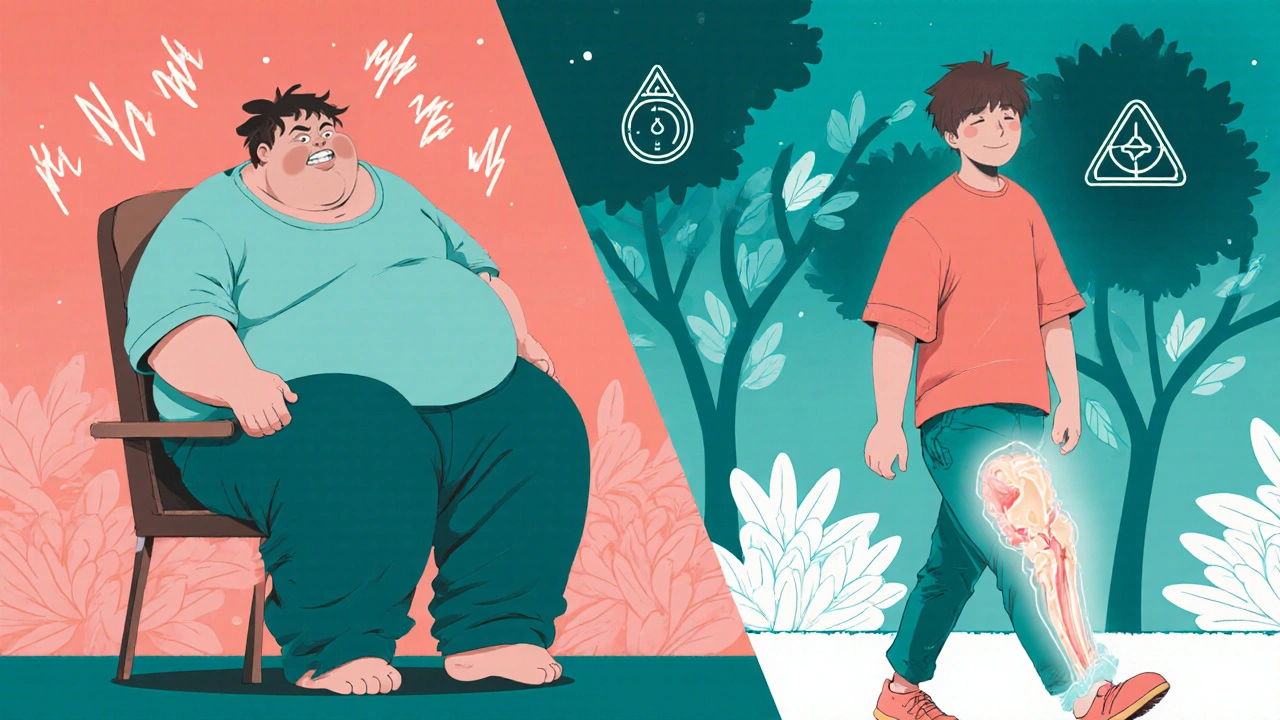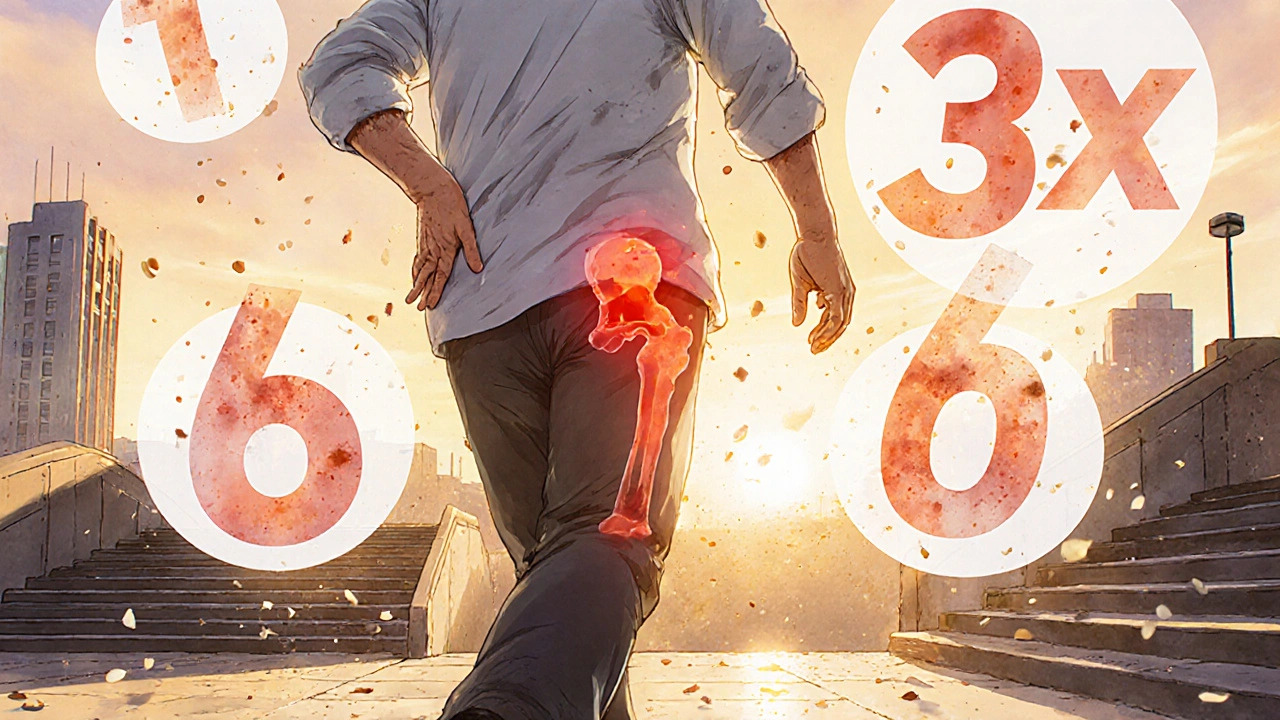When your hip starts to ache with every step, it’s not just about aging. For many people, especially those carrying extra weight, that pain is a sign of osteoarthritis of the hip-a slow, grinding breakdown of the cartilage that cushions the joint. Unlike knee osteoarthritis, where weight loss is widely accepted as a game-changer, the role of weight loss for hip OA has been debated. But new research is shifting the conversation. Losing even a small amount of weight isn’t just about fitting into jeans-it’s about protecting your hip joint, reducing pain, and keeping you moving longer.
Why Weight Matters for Your Hip Joint
Your hip joint bears your entire body weight with every step, squat, or climb up stairs. When you carry extra pounds, that pressure multiplies. For every pound of body weight, your hip joint experiences three to six times that force during movement. If you’re 30 pounds overweight, that’s an extra 90 to 180 pounds of stress on your hip with each step. Over time, this accelerates cartilage wear, triggers inflammation, and worsens pain. Unlike the knee, which is more directly affected by mechanical load, the hip is a deep ball-and-socket joint. That means its mechanics are different-and so is its response to weight loss. Some studies, like one published in NEJM Journal Watch in 2023, claimed weight loss doesn’t help hip OA. But that view is outdated. A major 2024 Nature study of 65-year-olds with hip OA and obesity showed clear results: those who lost more than 10% of their body weight saw the biggest improvements-not just in pain, but in quality of life, mobility, and daily function.How Much Weight Do You Need to Lose?
The old rule of thumb-lose 5% of your body weight to feel better-was based mostly on knee OA data. For hip OA, that number isn’t enough. The 2024 Nature study found that losing just 5% brought modest improvements. But losing 7-10%? That’s when people started noticing real changes. Those who lost over 10% saw up to a 31% improvement in their hip-related quality of life scores. Here’s what that looks like in real numbers:- If you weigh 200 pounds, losing 10% means shedding 20 pounds.
- If you weigh 250 pounds, that’s 25 pounds.
Weight Loss vs. Exercise: What Works Best?
Many people think exercise alone will fix hip pain. And it helps-but not enough if you’re carrying excess weight. A 2023 clinical trial compared two groups: one did only exercise, the other combined a very-low-calorie diet (VLCD) with exercise. After six months, both groups had similar pain levels. But by 12 months, the group that lost weight showed clear gains in pain reduction, mobility, and overall hip function. Why the delay? Because joint healing takes time. Losing weight reduces inflammation, but it also lets your body start repairing damaged tissues. That process doesn’t happen overnight. The key is consistency. People who stuck with the program long-term saw the biggest improvements. Exercise still matters. Strength training for your glutes, hamstrings, and core stabilizes the hip joint. Low-impact cardio like swimming, cycling, or walking reduces stiffness without pounding your joints. But without weight loss, you’re trying to fix a leaky roof with a bucket-constant effort, but the problem keeps coming back.
What Does the Science Say About Hip vs. Knee OA?
This is where confusion comes in. For knee osteoarthritis, weight loss is a no-brainer. The Framingham study showed that if obese men dropped into the overweight range, their risk of knee OA dropped by 21.5%. For women? A 33% drop. That’s huge. But hips? The response isn’t as sharp. The hip joint is deeper, more stable, and less directly loaded than the knee. That’s why some early studies missed the benefits. But newer, longer-term research is showing that while the pain relief might be slower, the impact is just as real. The 2024 Nature study found that weight loss improved all areas of hip function: pain, stiffness, daily activities, sports, and quality of life. That’s not a small win-it’s life-changing.How to Start Losing Weight With Hip OA
Starting a weight loss plan with hip pain sounds impossible. But it’s doable-with the right approach.- Focus on nutrition first. Cut sugary drinks, processed snacks, and refined carbs. Swap them for whole foods: vegetables, lean proteins, healthy fats, and fiber-rich grains. A low-carb or Mediterranean-style diet has shown strong results in managing OA symptoms.
- Move smart. Don’t push through pain. Try water aerobics, stationary biking, or seated resistance exercises. Even 20 minutes a day adds up.
- Track progress. Use a simple app or journal to log weight, food, and how your hip feels each day. You’ll see patterns-like how certain foods make your pain worse.
- Get support. Programs like OAHWFL use telehealth coaching, meal plans, and exercise guides tailored to people with hip OA. You don’t have to do this alone.




Jessica Healey
November 18, 2025 AT 09:39I lost 18 pounds last year and my hip pain? Gone. Not ‘less’-gone. I used to need a cane to walk to the fridge. Now I dance with my dog in the kitchen at 2 a.m. because I can’t sleep and I’m bored. No magic pills. Just cut the soda, ate more eggs, and walked slow around the block. My ortho didn’t even believe me at first. But my X-ray? Looked 10 years younger. Seriously. It’s not about being thin. It’s about not being a walking brick.
Levi Hobbs
November 18, 2025 AT 16:29This is so important-and so under-discussed. I’ve seen patients in my clinic who’ve been told, ‘Just exercise more,’ but they’re carrying 40+ extra pounds, and their hips are screaming. Exercise without weight loss is like trying to fill a bucket with a hole in the bottom. The 2024 Nature study is a game-changer. Losing 10% isn’t just ‘good’-it’s clinically transformative. I’ve started recommending the OAHWFL protocol to everyone over BMI 30 with hip OA. The results? Consistent. And it’s not about willpower-it’s about reducing mechanical load. Simple physics.
henry mariono
November 19, 2025 AT 05:14I’ve been dealing with this for 7 years. I didn’t believe weight loss would help my hip-not like it does for knees. But I tried. Lost 14 pounds over 6 months. Didn’t even notice the number on the scale. What I noticed? Standing in line at the grocery store didn’t make me want to cry anymore. I started taking the stairs again. It’s not glamorous. But it’s real. I’m not ‘fixed.’ But I’m not quitting either.
Sridhar Suvarna
November 19, 2025 AT 14:24As someone from India where joint pain is often dismissed as ‘just aging’-this article is a lifeline. In my village, people think pain means you’re weak. But science says otherwise. Losing even 5 kg changed my mother’s life. She walks to the temple now. No pain. No pills. Just food changes and walking after dinner. We need more awareness. Not just in the West. In villages, in towns, everywhere. Weight loss is not vanity-it is dignity.
Joseph Peel
November 19, 2025 AT 16:21There’s a cultural blind spot here. In many communities, especially among older adults, weight loss is framed as a cosmetic goal-not a medical necessity. The fact that hip OA responds differently than knee OA is critical. We need public health messaging that reflects this. Not ‘lose weight to look good’-but ‘lose weight to keep walking.’ The data is clear. The stigma is not. We must reframe this as joint preservation, not body shaming.
Kelsey Robertson
November 20, 2025 AT 13:07Oh please. Another ‘weight loss is the cure’ article. What about the people who are ‘overweight’ but metabolically healthy? Or those with thyroid issues? Or people who’ve been dieting since they were 12 and are now mentally broken? You act like losing 10% is some magical elixir-when in reality, it’s a band-aid for a broken healthcare system that doesn’t fund physical therapy, doesn’t subsidize healthy food, and blames patients for systemic failure. This isn’t empowerment-it’s victim-blaming with citations.
Joseph Townsend
November 21, 2025 AT 01:39I was a walking disaster. 280 pounds. Hip screaming like a banshee. Tried everything. Then I ate like a normal human-no more 3am pizza, no more ‘I deserve it’ mentality. Lost 26 pounds. Didn’t even know I was doing it. Now I can pick up my niece without grunting like a bear. My dog looks at me like I’m a superhero. My ortho said, ‘You didn’t get surgery? Wow.’ I said, ‘Nah. I just stopped being a trashcan.’ Life’s too short to walk like you’re dragging a sack of bricks. Do the work. Not for them-for you.
Bill Machi
November 22, 2025 AT 17:26Another liberal health myth pushed by elite academia. You think losing weight is the answer? What about the millions who can’t afford organic food? Who work two jobs? Who live in food deserts? This isn’t about personal responsibility-it’s about class warfare disguised as medicine. Hip OA is genetic. It’s environmental. It’s not your fault you’re fat. Stop shaming people. And stop pretending this is science-it’s moralizing with a lab coat.
Elia DOnald Maluleke
November 24, 2025 AT 03:37In South Africa, we say: ‘The body remembers what the mind forgets.’ I lost weight after my hip diagnosis-not because I wanted to, but because I had to. I used to sit all day, afraid to move. Then I started with 5 minutes of water walking. Then 10. Then I cooked my own food. No more samp and beans every day. Now I walk to the market. I feel… human again. This is not a trend. It is survival. And it is quiet. No one cheers. But the silence of pain? That is the loudest victory.
satya pradeep
November 25, 2025 AT 07:39Bro i tried the 10% thing and it worked but only after i stopped chasing the scale and started chasing sleep and protein. My hip felt better before i lost 5 lbs. Why? Because i stopped eating junk after 8pm and slept 7 hours. Weight loss is 80% sleep and stress. The rest is just food. Also-try turmeric milk. Not a joke. My uncle in Punjab uses it for 40 years. Works. Not magic. Just biology.
Prem Hungry
November 26, 2025 AT 06:01Dear friend, if you are reading this and feeling hopeless-please know you are not alone. I have guided over 200 people with hip OA, and every single one of them started with fear. But progress is not linear. Some days you eat well. Some days you don’t. Some days your hip hurts more. That’s okay. The goal is not perfection. The goal is consistency. Start with one healthy meal. One short walk. One glass of water instead of soda. Small steps. Big change. You are stronger than your pain. I believe in you.